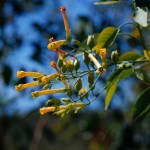Tree tobacco
Nicotiana glauca
Solanaceae (Nightshade family)
Description
Tree tobacco is a loose-branching, small, evergreen tree or shrub between 6 and 18 feet tall.
The large, lance-shaped, smooth leaves appear on short stalks opposite each other low on the branches. The upper leaves lack stalks and lie in a somewhat upward angle against the branch.
White, yellow, greenish or red, trumpet-shaped flowers open at night and are 0.5 to 1.5 inches long.
Habitat
Tree tobacco is a native of South America, but is naturalized along streams and roadsides in low elevation, semi-arid areas of the southwestern United States. In the Big Bend area of Texas, it occurs frequently along the Rio Grande and smaller streams and in southern Texas as well. Tree tobacco is also used as an ornamental.
Toxic Agent
The tobaccos contain the toxic alkaloids nicotine and anabasine, and all parts of the evergreen plant are toxic year-round.
In Texas, cattle and horses are most frequently poisoned. The toxic dose for horses is 0.5 percent of body weight in leaves, while poisonings in cattle are reported at 2 percent of the body weight. Swine, sheep and probably goats are also susceptible.
Signs of Livestock Ingestion
Signs appear shortly after consumption of acutely toxic amounts. They may include: stumbling, muscle trembling, salivation, frequent urination, vomiting, diarrhea, and death due to respiratory paralysis
Birth defects, crooked legs and/ or cleft palate may occur in young when the mother consumed a low level during the first trimester of pregnancy.
Management Strategies
The plant is generally unpalatable to livestock. Maintaining good range condition and an adequate forage supply is the best way to avoid problems.
Activated charcoal may be of some use in treating acutely poisoned animals.
Images
Plant Characteristics
Flower Color: White, Yellow
Seed Type: Non-Encapsulated
Duration: Perennial
Stem Texture: Hairless/Smooth
Growth Habit: Shrub (Woody)
Leaf Shape
 : Simple with Pinnate or Parallel Venation
: Simple with Pinnate or Parallel Venation
Season: Evergreen
Distribution
 : 02 - Gulf Prairies and Marshes, 06 - South Texas Plains, 07 - Edwards Plateau, 10 - Trans-Pecos
: 02 - Gulf Prairies and Marshes, 06 - South Texas Plains, 07 - Edwards Plateau, 10 - Trans-Pecos
Distributions
Distribution refers to the ecological region in Texas that a plant has been found. You can also view a clickable map.
Book: Toxic Plants of Texas (B-6105)
Collection: Toxics
Livestock Affected: Cattle, Goats, Horses, Sheep
Livestock Signs: Abnormal Urination, Birth Defects, Diarrhea, Excess Salivation, Incoordination, Irregular Breathing, Trembling, Unable To Rise






